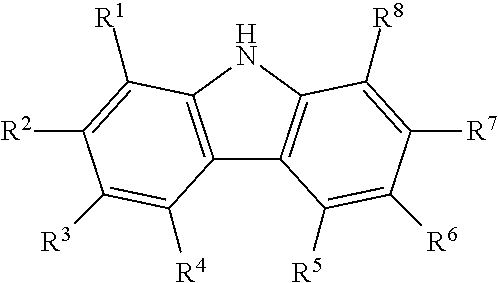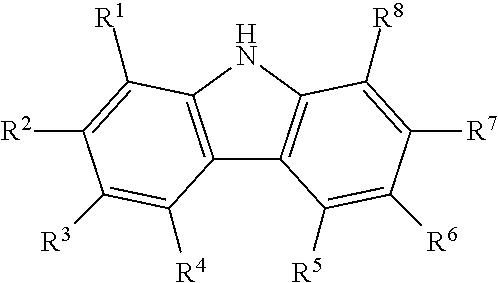Process for producing diaryl carbonates
a diaryl carbonate and process technology, applied in the field of diaryl carbonate production, can solve the problems of high cost, corroded equipment, and very toxic substances of phosgene and methyl chloroformate, and achieve the effect of low reaction pressure and high reaction convertibility
- Summary
- Abstract
- Description
- Claims
- Application Information
AI Technical Summary
Benefits of technology
Problems solved by technology
Method used
Image
Examples
examples 1-5
The steps of the Comparative Example were repeated except that different organic cocatalysts were added and the molar ratio of the organic cocatalyst to the catalyst was 1:1. The results are shown in Table 1. It is shown that, in a certain extent, the yields are all increased when the palladium chloride catalyst is used in combination with different cocatalysts.
TABLE 1The benefit of palladium chloride in combination with differentcocatalysts to the improvement on the yield of diphenyl carbonateConvertibilitySelectivityYieldCocatalyst(%)(%)(%)CEx.none5.998.95.8Ex. 1carbazole7.2100.07.2Ex. 23,6-dibromocarbazole10.399.110.2Ex. 33,6-diaminocarbazole10.4100.010.4Ex. 42-acetylcarbazole8.499.38.3Ex. 52-hydroxybenzo[a]carbazole-9.099.38.93-carboxylic acid sodium saltCEx. = Comparative ExampleEx. = Example
examples 6-7
The steps of the Comparative Example were repeated except that palladium chloride was used in different concentrations and the cocatalyst of 3,6-dibromocarbazole was used in a molar ratio of 1:1 with respect to the catalyst. The results are shown in Table 2. It is shown that the cocatalyst will benefit the production of diphenyl carbonate under different concentrations of the palladium chloride catalyst.
TABLE 2The influence of the cocatalyst on the synthesis of diphenylcarbonate under different concentrations of palladium halidePd concentration(ppm)Convertibility (%)Selectivity (%)Yield (%)Ex. 226510.399.110.2Ex. 61327.099.16.9Ex. 710006.898.96.7Ex. = Example
example 8
The steps of the Comparative Example were repeated except that the reaction was carried out at a different reaction pressure and the cocatalyst as used was 3,6-dibromocarbazole. The result is shown in Table 3. It is shown that, with the use of the cocatalyst of the present invention, a higher yield than that of the original system can still be obtained at different pressures.
TABLE 3The influence of pressure on the production of diphenyl carbonateReaction pressure(kg / cm2)Convertibility (%)Selectivity (%)Yield (%)Ex. 21010.399.110.2Ex. 886.598.86.4Ex. = Example
PUM
| Property | Measurement | Unit |
|---|---|---|
| temperature | aaaaa | aaaaa |
| temperature | aaaaa | aaaaa |
| pressure | aaaaa | aaaaa |
Abstract
Description
Claims
Application Information
 Login to View More
Login to View More - R&D
- Intellectual Property
- Life Sciences
- Materials
- Tech Scout
- Unparalleled Data Quality
- Higher Quality Content
- 60% Fewer Hallucinations
Browse by: Latest US Patents, China's latest patents, Technical Efficacy Thesaurus, Application Domain, Technology Topic, Popular Technical Reports.
© 2025 PatSnap. All rights reserved.Legal|Privacy policy|Modern Slavery Act Transparency Statement|Sitemap|About US| Contact US: help@patsnap.com



